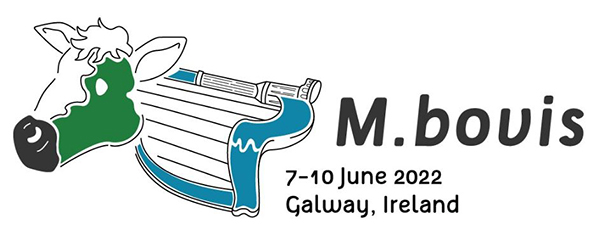Identification of an IS6110-like insertion sequence in M. avium subsp. hominissuis: significance and perspectives in the diagnosis of bovine tuberculosis
Comunicación presentada en Seventh International Conference on Mycobacterium bovis
7 de junio de 2022
Lorente-Leal V., Moya N., Munoz M., Romero B. y de Juan L.
The IS6110 element is commonly used for the detection of Mycobacterium tuberculosis complex (MTBC) DNA in human and veterinary samples. During the validation of a real-time PCR targeting this mobile genetic element, cross-reactivity against one ‘Mycobacterium avium subsp. hominissuis’ (MAH) isolate was detected (Lorente-Leal et al., 2021). Due to the extended use of this mobile element in the diagnosis of bovine tuberculosis, this phenomenon was evaluated further. The cross-reacting MAH strain was analysed through Whole Genome Sequencing. To assess the extension and significance of this interference, a selection of MAH isolates obtained from 124 herds in a Spanish region with very low bovine tuberculosis herd prevalence (0.05% in 2018) were analysed with the IS6110 Real-Time PCR.
Genomic data revealed a truncated IS6110-like element, 1245 bp long and 83% similar to the IS6110 from M. tuberculosis. This IS6110-like element was deemed inactive due to an incomplete 3’-extreme and a 5-bp long insertion in the Left Inverted Repeat. Sequences with 100% coverage and identity were detected in other MAH strains and two other M. avium complex species (M. bouchedurhonense and M. timonense). Seventy-four percent (92/124) of the MAH isolates were positive to this PCR, suggesting that, although it was frequently found in the selected sample population, it was not conserved in all MAH strains.
This study describes for the first time the existence of an IS6110-like element in certain MAC species and suggests the occurrence of previous DNA exchange with MTBC. Although the IS6110 real-time PCR offers very good diagnostic performance, the use of the IS6110 element, or any other transposable sequence, should be considered strategically taking into account the epidemiological situation and the prevalence of bTB in the region. The use of additional markers, such as mpb70 or MAC-specific targets, could be of special interest to increase the specificity of real-time PCR detection of bTB in low prevalence settings (e.g. < 1% in Spain) or in herds with a history of non-tuberculous mycobacteria isolation
 | Servicio de Micobacterias (MYC). Centro de Vigilancia Sanitaria Veterinaria (VISAVET). Universidad Complutense (UCM). |
 | Departamento de Sanidad Animal. Facultad de Veterinaria. Universidad Complutense (UCM). |
| Servicio de Sanidad Animal. Consellería do Medio Rural. Xunta de Galicia. | |
Enlace a Seventh International Conference on Mycobacterium bovis


